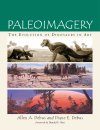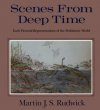By
Leon (NHBS Catalogue Editor)
30 Oct 2017
Written for Hardback

Palaeoart (not to be confused with Palaeolithic art, i.e. cave paintings) has a long and rich history of artworks that have helped us imagine the prehistoric past, from dinosaurs and mammals to cavemen. As an art genre though, it is largely ignored and looked down upon a bit, popular as these images are with children and the unwashed masses. This book aims to set the record straight and celebrate a carefully curated selection of palaeoart covering some 150 years, from the first works in the 1830s up to the 1980s. The book calls itself a two-fold time machine. Or, to paraphrase American artist Walton Ford in his preface, the book is a look back in time at what looking back in time looked like.
Before I even get to the contents of the book, I have to remark on the physical object itself. The German publisher Taschen is well known for its large, luxurious art books, reproducing anything from classical paintings to modern photography. Though not the largest format in their range, this book is nevertheless a beast, measuring some 29 by 38 cm with an embossed dustjacket. Not really bedtime reading, unless you have a large bed. The cover features a textured, knobbly surface, mimicking reptilian skin (something that some of the
Life of the Past volumes from Indiana University Press also feature), in which is debossed a reptilian footprint on the front cover. The endpapers feature a reproduction of an 1840 black-and-white etching,
The Sea-Dragons as They Lived by John Martin. Very stylish.
As mentioned, the preface is contributed by Walton Ford, but the eight chapters and conclusion are written by art critic and journalist Zoë Lescaze. After introducing the earliest illustrations and illustrators and why they made their works, subsequent chapters focus on particularly influential artists. There are the works of Englishmen such as Benjamin Waterhouse Hawkins, who introduced audiences in Victorian Britain to prehistorical creatures and crafted enormous sculptures first exhibited in London’s Crystal Palace, and Neave Parker and Maurice Wilson, who were active in the 1950s and ’60s and had very contrasting styles. There are those of the Americans Charles R. Knight (more on him in
Charles R. Knight: The Artist Who Saw Through Time), who imbued his work naturalistic accuracy, and Rudolph Zallinger, whose enormous fresco,
The Age of Reptiles, is famous the world over. It is probably one of the few artworks of its sort that has been the subject of
a separate book (kudos to Yale University Press for that). And there is a selection from the incredibly productive Czech artist Zdeněk Burian, whose work I admit I was not familiar with.
But there’s also space reserved for more obscure work, forgotten and unknown, such as Heinrich Harder’s art nouveau murals that once graced the walls of the Berlin zoo and aquarium. These were destroyed in bombings during World War II and later reconstructed from original drawings discovered years later. And then there is Russia, which is home to some truly remarkable and poorly known treasures. Colourful paintings from the hand of Konstantin Konstantinovich Flyorov, the obscenely large mosaic
Tree of Life by Alexander Mikhailovich Belashov, and another immensely large fresco,
Late Cretaceous Landscape of the South Gobi, by Mai Petrovich Miturich-Khlebnikov and Viktor Aronovich Duvidov, the latter two found in the Orlov Palaeontological Museum in Moscow.
As interesting and enlightening as the essays are (and the cast of artists described is a remarkable bunch), the main reason for buying this book is of course the illustrations. And, wow, what a treasure trove this book is, reproducing a large number of works in splendid colours on heavy paper stock. Some of the smaller works are reproduced life-size, and many of the large works are reproduced on dedicated single or double-page spreads. There are also several sprawling fold-out spreads, reproducing the large murals. For some reason, The
Age of Reptiles is not laid out in a continuous fashion from left to right, meaning you have to leave back and forth to follow the natural progression in this painting.
Paleoart is not intended to be a comprehensive catalogue of all historical palaeoart. The body of work is simply too vast to contain in any one volume, so Lescaze has had to carefully curate the selection for this book. Similarly, this is first and foremost a book about the art-side of palaeoart, rather than the palaeo-side. There are plenty of books on the market showcasing contemporary palaeoart, but there are only a few other books I know of that cover its history. Besides the above-mentioned, Indiana University Press’s
A History of Paleontology Illustration and McFarland’s
Paleoimagery: The Evolution of Dinosaurs in Art come to mind. 18th and 19th century palaeoart was also previously written about in Rudwick’s
Scenes from Deep Time. Even so, this book is unrivaled in its size, coverage and production values. If you are seriously interested in this topic, the hefty price-tag is very much worth it.















































![A Garden Eden: Masterpieces of Botanical Illustration [English / French / German]](http://mediacdn.nhbs.com/jackets/jackets_resizer_medium/25/257076.jpg?height=150&width=112)
![The Garden at Eichstatt (3-Volume Set) [English / French / German]](http://mediacdn.nhbs.com/jackets/jackets_resizer_medium/26/263535.jpg?height=150&width=180)